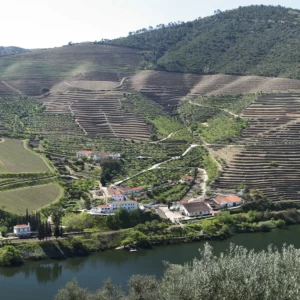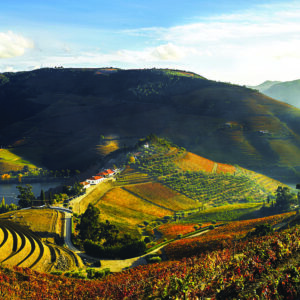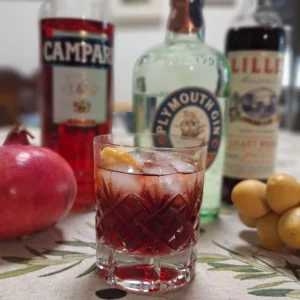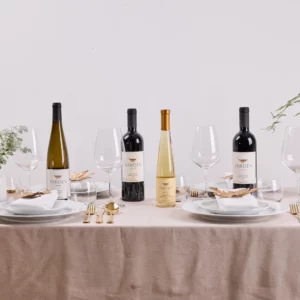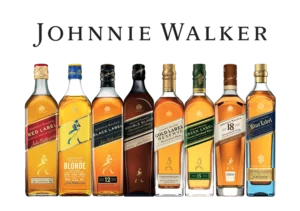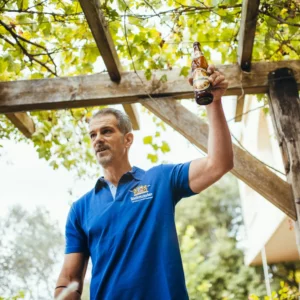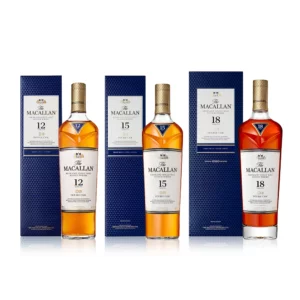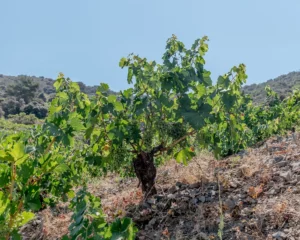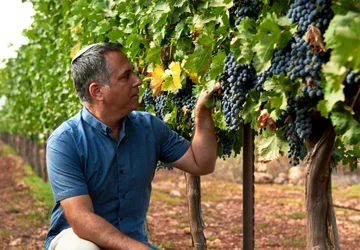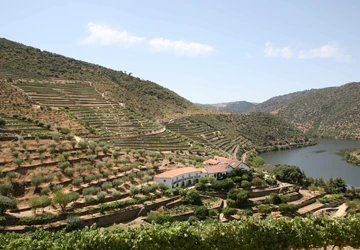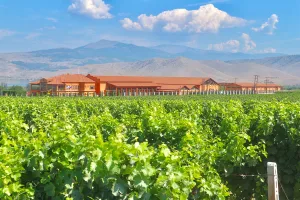It is an oddity that in Israel there are no indigenous wine varieties. There are indigenous food grape varieties like Dabuki or olive oil varieties like the Souri, but wine varieties none. It is strange because in nearby countries like Cyprus, there are numerous indigenous varieties and many of the noble varieties like Shiraz and Chardonnay are said to have originated in the Middle East.
In 1882 when Baron Edmond de Rothschild recommended the planting of grapes in Israel, the settlers originally chose hardy Spanish varieties like Bourdalou and Braquet. It appears that indigenous varieties had been uprooted in previous years.
In 1887 Rothschild visited what was then known as Palestine and initiated the planting of the famous Bordeaux varieties such as Cabernet Sauvignon, Malbec and Cabernet Franc. His objective was to make a really fine wine and he berated his officials who showed any doubts. He sent teams of experts from Bordeaux, installed a Bordeaux winemaker at the Rishon le Zion Wine Cellars and even in the early 1890’s sent the Chateau Lafite winemaker to Israel to act as a consultant to the new wineries.
However nature had other ideas. In the mid 1890’s the new Israeli vineyards became affected by phylloxera, a louse that was devastating the world’s vineyards. By that time Rishon Le Zion and Zichron Yacov Wineries realized that the market for high quality was too steep for an Israeli wine, but that there was a realistic market for inexpensive wines. Plans were changed and between 1896 and 1899. Vines were uprooted and replaced with the cruder Carignan, Grenache and Alicante. Cuttings were brought from India to avoid the phylloxera plague. These varieties, being used in the South of France, were considered more suitable for the hot, humid climate in Palestine.
The new Israeli wine industry was therefore built on Carignan and Grenache for red wines and Semillon for white wines. In the 1960’s, Carmel became the first winery to reintroduce Cabernet Sauvignon and Sauvignon Blanc. The first Israeli varietals were exported in 1970. They were Cabernet Sauvignon, Sauvignon Blanc, Grenache Rose and Semillon (semi dry).
Then the Golan Heights Winery was formed in 1983 and introduced to Israel the first Merlot and Chardonnay. Cabernet Franc, Gewurztraminer, Pinot Noir, Sangiovese and Viognier were to follow. Eventually most of accepted international varieties would reside in Israel.
In the 30 years between the production of Israel’s first international class wine, the Carmel Special Reserve 1976 and the release of Carmel Limited Edition in 2006, there have been a continuous stream of world class Israeli wines led by Yarden, and small wineries such as Castel, Flam, Margalit and Yatir. However nearly all of their best red wines were made from Cabernet Sauvignon grapes or based on a blend of Cabernet Sauvignon and Merlot. Though many predict that Shiraz or Syrah will become Israel’s main quality variety in the future, Cabernet Sauvignon still rules.
In most wine producing countries of the world, there is signature variety for which a particular country is primarily known. If the left bank of Bordeaux is known for Cabernet Sauvignon and the right bank for Merlot; Burgundy means Pinot Noir and Chardonnay. Australia has Shiraz, Argentina Malbec, California Zinfandel, Chile Carmemere, Italy Sangiovese & Nebbiolo, New Zealand Sauvignon Blanc, Spain – Tempranillo and South Africa Pinotage. Of the smaller countries, Georgia has Serapavi, Greece – Aghiorghitiko and Xynomavro, Uruguay Tannat. What is the national grape of Israel
The international grape variety most unique to Israel is Emerald Riesling. This is a hybrid developed by the University of California in 1948 in an attempt to produce a quality Riesling in the hot climate of California. Emerald Riesling’s parents were the White Riesling (Johannisberg) and the boring Muscadelle. In fact the only place this variety succeeded was in Israel. The variety was introduced to Israel in the 1970’s and by the mid 1980’s Emerald Riesling became Israel’s biggest selling brand of semi dry (sometimes semi sweet) white wine. Emerald Riesling wines became responsible for introducing many new drinkers to wine, performing the same task as Liebraumilch in England and Lambrusco in America. However though the standing of the variety represents volume and value rather than an expression of fine wine, it is seen at its best in the Private Collection Emerald Riesling, which has far less residual sugar than is customary and is the perfect wine to accompany Asian food.
The variety most common to the Eastern Mediterranean basin is the Muscat of Alexandria, which is considered one of the oldest vines in existence. It is usually cultivated for raisins, but in Greece, particularly on the island of Samos, Cyprus, and Israel, it has long been a variety for making aromatic, sweet dessert wines. This Muscat is said to have its roots in North Africa, but its home since then has been the Eastern Mediterranean. The Yarden Muscat, Binyamina semi dry and dessert Muscats and Carmel’s Muscat of Alexandria have all won major gold medals with this variety.
The only real ‘sraeli variety is Argaman, which means deep purple in Hebrew. Argaman was a cross between the Portuguese grape Souzao and Carignan, developed by the Israel Wine Institute and the Volcani Center. It was planted in the early 1990’s with the objective developing a grape more resistant to disease and with better color than Carignan. It is today used to best effect by Barkan/ Segal as a blender for more inexpensive wines, but has not lived up to expectations.
Neither Muscat of Alexandria, Emerald Riesling or Argaman are of the quality, nor do they have the potential to create enough interest, to be described as the national varieties of Israel. White (Johannisberg) Riesling and Muscat Canelli (Frontignan) were introduced in the late 1980’s and early 1990’s respectively and producing better quality than their predecessors. Furthermore enough Cabernet Sauvignon and Merlot was planted in the 1990’s to be available for use in cheaper blends. So the original Muscat, Emerald and Argaman became less important.
However there are two much abused varieties Carignan and Petite Sirah, which maybe do fit the bill to be considered as the potential national varieties of Israel. Both are undergoing a quality revival and creating a great deal of interest amongst wine lovers and connoisseurs. When produced with an eye on quality, the Carignan can produce wines which have a nose of strawberry, raspberry & cherry fruit, with good acidity and a backdrop of Mediterranean herbs & spices. Petite Sirah wines, on the other hand, will be an almost black blockbuster, with intense tannins and an enticing aroma of black fruit and violets.
Carignan is a workmanlike variety found in Spain and France. It is the largest planted variety in France, almost all of it in the Languedoc-Roussillon and Provence. It is known as Carignane in America, Carignano in Italy and Carinena or Mazeulo in Spain. In the 1990’s this variety underwent a revival in areas such as Corbieres in France and Priorat in Spain. They discovered that Carignan could produce wines of real character. The secret was to select older vines and drastically cut yields.
Carignan is also a variety prevalent in the Mediterranean basin surrounding Israel. It is prolific in Cyprus, Lebanon and Turkey. In Israel it remains the largest planted variety since being brought to Israel by Baron Edmond de Rothschild in the late 1890’s. Since those days a large number of Carignan vineyards have been grubbed up in favor of noble varieties but it still represents 20% of Israel’s vineyards. Until recently it was mainly used just for producing inexpensive wine blends, sweet sacramental wines and grape juice. Carignan was usually the worst or cheapest wine in a winery’s portfolio.
In the 1980’s the Carignans from Askalon Wines, produced by the Segal family, were some of the best regarded red wines in the country. The variety though, was mainly used a blender for wines masquerading as Cabernet Sauvignon. The breakthrough came when Yair Margalit produced Israel’s first quality Carignan in 1999. It was a one-off, with 5% Cabernet Sauvignon to provide backbone, but the first time a top boutique winery had given attention to this much maligned variety. The next pioneer was Asaf Paz, who believed in the variety and developed it both when he worked at Carmel and at the boutique winery called Vitkin.
The results of Carmel Winery’s decision to revive the Carignan grape has led to a reappraisal of Carignan by the industry. They produced an Appellation (Sidrat Eizory) Carignan from two 30 year old vineyards in the Zichron Yacov area. Instead of the usual 3, or sometimes even 4 tons to the dunam, yields were reduced to a mere 0.8 tons per dunam. (10 dunams = 1 hectare.) The wine was made from 90% Carignan and 10% Petite Verdot (from a nearby Binyamina vineyard) and was aged in French oak barrels for a year in Carmel’s 100 year old Zichron Yacov Wine Cellars. Recognition came with a gold medal at Terravino in 2006.
Petite Sirah, otherwise known in France as Durif, is another variety to be revived. It is a sometimes spelt Petite Syrah in America. It made aliyah to Israel in the 1970’s and was used for inexpensive wines. In the early 1990’s there were those who tried to mislead by marketing their Petite Sirah wines as Shiraz, which was derided because it was thought the Petite Sirah had nothing in common with Syrah. It was only in 1998, that the University of California confirmed that Durif was the result of a cross pollination between an old French grape Peloursin and Syrah. So they were related after all! In any event, Petite Sirah certainly makes distinctive wines mainly in California , Australia and in Israel.
The first time Petite Sirah was seen as a quality variety was when Yair Margalit insisted it was an essential part of the Margalit Special Reserves. He considered the 5% to 15% of Petite Sirah as an important ingredient to the success of his flagship wine. Wineries like Yiftachel, Vitkin amongst the boutique wineries and Carmel and Recanati amongst the commercial wineries have also specialized in the variety. Recanati have won awards for their Petite Sirah Zinfandel blend and Carmel’s Appellation Petite Sirah from old vines in the Judean Hills has also gained plaudits as one of the most interesting, characterful wines available.
Whatever happens to these varieties in the future will determine if they may, in future, be regarded as the national variety of Israel. The mission to revive Carignan and Petite Sirah should be supported by growers, wineries and consumers. It provides much needed variety, quality and the curious wine lover has an alternative to the all conquering Cabernet and Merlot.
Adam Montefiore



